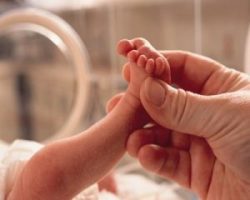- Home
- Editorial
- News
- Practice Guidelines
- Anesthesiology Guidelines
- Cancer Guidelines
- Cardiac Sciences Guidelines
- Critical Care Guidelines
- Dentistry Guidelines
- Dermatology Guidelines
- Diabetes and Endo Guidelines
- Diagnostics Guidelines
- ENT Guidelines
- Featured Practice Guidelines
- Gastroenterology Guidelines
- Geriatrics Guidelines
- Medicine Guidelines
- Nephrology Guidelines
- Neurosciences Guidelines
- Obs and Gynae Guidelines
- Ophthalmology Guidelines
- Orthopaedics Guidelines
- Paediatrics Guidelines
- Psychiatry Guidelines
- Pulmonology Guidelines
- Radiology Guidelines
- Surgery Guidelines
- Urology Guidelines
Calcium deposits in womb linked to preterm births: Study

Washington : Researchers have uncovered a surprising possible trigger for some preterm births: calcium buildup in the womb, similar to the kind that stiffens older people's arteries or causes kidney stones.
Ohio researchers studying more than 100 pregnant women found that when a mom to be's water breaks too early, the culprit seems to be abnormal calcium deposits that make the normally elastic amniotic sac prone to rupture.
It's a small study and more research is needed to prove if calcification really is behind this baffling kind of prematurity and if so, what to do about it. But the research, reported in Science Translational Medicine, raises the possibility of investigating interventions.
"To have a new potential mechanism for one significant form of preterm birth is quite exciting," said Dr. Edward McCabe, chief medical officer of the March of Dimes, who wasn't involved in the study.
Premature birth being born before 37 weeks of pregnancy can cause lifelong health problems, and babies who are very premature can die. Sometimes there's an obvious cause for prematurity, such as an infection. Yet most of the time, doctors can't explain what triggers preterm birth in an otherwise healthy pregnant woman.
Dr. Irina Buhimschi of Nationwide Children's Hospital took a closer look at a curiosity: Calcified plaques have often been spotted in placentas after birth both preterm and full term and no one knows why.
But abnormal calcification is well-known to play a role in a number of disorders. Clusters of minerals, known as calciprotein particles, that float in the blood may be deposited in soft tissue instead of the skeleton, leading to such problems as artery-stiffening atherosclerosis or kidney stones.
Could that process go awry in preterm birth, too? Buhimschi's team found higher concentrations of the calcium-containing deposits in the amniotic sac when a mom's water broke prematurely than with full-term births or other types of preterm births.
Amniotic fluid can produce calciprotein particles, the team found and with preemies, that fluid also contains lower levels of a protein named fetuin-A that's supposed to keep those deposits from being dumped in the wrong place, like the amniotic sac. Lab experiments found those deposits led to less flexible fetal membranes.
"We've shown that formation of these particles in amniotic fluid is unhealthy, and we need to keep it in check," Buhimschi said.
Importantly, testing mom's blood didn't uncover any signal that a problem was brewing. Buhimschi said the problem may be restricted just to the amniotic fluid if the fetus' own organs simply don't produce enough fetuin-A to protect itself. But that would pose a barrier to uncovering at-risk pregnancies, because testing amniotic fluid is risky.
It's a plausible theory, said Dr. Catherine Spong, a maternal-fetal specialist at the National Institute of Child Health and Human Development.
But "the clinical relevance of this finding remains to be explored," Spong cautioned. "Preferably noninvasive methods for detection might allow for the development of interventions or the opportunity for prevention."

Disclaimer: This site is primarily intended for healthcare professionals. Any content/information on this website does not replace the advice of medical and/or health professionals and should not be construed as medical/diagnostic advice/endorsement or prescription. Use of this site is subject to our terms of use, privacy policy, advertisement policy. © 2020 Minerva Medical Treatment Pvt Ltd